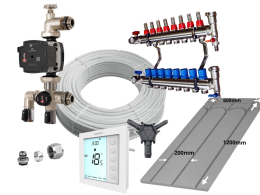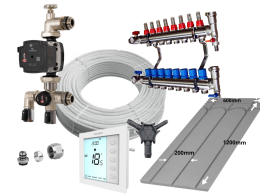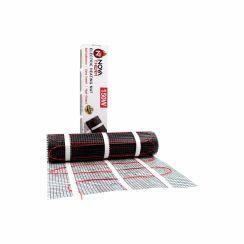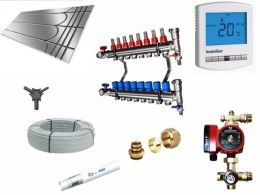Key Points:
- Building regulations for conservatories
- Different types of conservatory bases
- Both water and electric underfloor heating work in conservatories
- Creates a cosy and comfortable conservatory all year round
Menu
- Benefits Of Underfloor Heating In Your Conservatory
- Which System Is Best For Your Conservatory Underfloor Heating?
- Choosing The Right Underfloor Heating For Your Conservatory's Base
- Building Regulations For Conservatories
- Causes Of Heat Loss In Your Conservatory
- How Much Is Underfloor Heating Conservatory Installation?
Benefits of underfloor heating in your conservatory
Many use conservatories primarily during the summer to bask in the sunshine and enjoy garden views. Installing underfloor heating in a conservatory transforms this space, making it usable and comfortable throughout the year. With conservatory underfloor heating, you can enjoy sunny winter days from a cosy and warm environment inside your home. This system provides efficient conservatory heating without bulky radiators, offering a clean and spacious look. Underfloor heating for a conservatory or extension ensures even warmth and maximizes your enjoyment of the space in all seasons.
Installing underfloor heating in a conservatory offers several advantages:
- Year-Round Comfort: Underfloor heating ensures your conservatory is warm and inviting, even in colder months. It's a reliable solution that allows you to enjoy your space throughout the year, not just in summer, providing a consistent and comfortable environment.
- Even Heat Distribution: Unlike traditional radiators, underfloor heating provides uniform warmth throughout the floor. This eliminates cold spots and creates a cosy environment.
- Space-Saving Design: By removing the need for bulky radiators, underfloor heating frees up wall space, giving you more flexibility in your conservatory's design and layout.
- Efficient and Cost-Effective: Underfloor heating operates at lower temperatures and is highly efficient. It uses energy effectively, helping to reduce your heating bills while maintaining comfort.
- Minimal Visual Impact: The system is installed beneath the floor, so it remains hidden, preserving the clean, open look of your conservatory without obstructive heaters.

Which system is best for conservatory underfloor heating?
Two primary types of underfloor heating systems are to consider: electric or water underfloor heating. Both types offer practical ways to keep your conservatory warm, but their installation and running costs differ.
Electric underfloor heating:
Electric underfloor heating systems are popular due to their ease of installation and efficiency. These systems work by using a network of heating cables or mats installed underneath your conservatory flooring and controlled via a thermostat. Electric underfloor heating is used for different flooring types, such as tiles, carpets, or laminate. Electric systems often come in various outputs and are generally recommended for conservatories due to their higher heat loss. Installing electric underfloor heating is typically less disruptive than water underfloor heating and heats up within 20-30 minutes. However, the running costs can be higher over time.
Water Underfloor Heating:
Water underfloor heating kits use a network of pipes installed beneath the floor that circulate warm water at around 45°C to heat the floor and warm the room. This type of underfloor heating connects to a boiler from your central heating system or an external unit. Water underfloor heating is particularly effective in conservatories if they are part of a new-build project where the system can be integrated into the initial construction.
Installing a water-based system can be more invasive and costly as it involves more plumbing work and potentially disruptive modifications to existing setups. This also means the repairs can be more challenging to access and find. Water underfloor heating generally offers lower running costs and is often preferred for larger or well-insulated spaces.
Choosing the right underfloor heating for your conservatory's base
To ensure you get the most efficient results from installing underfloor heating in your conservatory flooring, you can use this guide to check which flooring would work best for you.
Concrete base:
A concrete base is a widely favoured option, although it requires additional time for concrete to set. Concrete bases provide better results when installed with underfloor heating systems.
Wooden base:
Thick timber lengths are utilised and secured with bolts to create a sturdy foundation, particularly suitable for areas with challenging slopes. If your home has a slope or is built on uneven ground, a wooden base will provide better results for your conservatory.
Raised flooring:
This option, which is more costly, relies on the conservatory walls to bear the weight. It is a more intricate method typically employed in sloped landscapes.
Is the base important?
The choice of substrate influences the construction of your underfloor heating system. For concrete substrates, use undercoated insulation boards, while for timber substrates, coated insulation boards are advised to enhance rigidity.
Before you question the necessity of insulation boards, the answer is yes! Without them, your underfloor heating system would be less efficient and would result in higher running costs.
Tiled and Stone Flooring
When opting for tile or stone floors in your conservatory, there are many choices. You can either install a heated and decoupled system or utilise a heating mat consisting of pre-spaced heating cables secured to mesh matting.
It’s crucial to remember that tiled floors can be prone to cracks and gaps due to temperature fluctuations. For this reason, we generally recommend the installation of a heating and decoupled system for any conservatory projects. This type of underfloor heating system is specifically designed to prevent cracking, lifting, and delamination of tiled floors, while also providing a decoupling layer that allows independent movement of the tiled surface from the substrate.
Another advantage of this particular heating system is its ability to offer different heating outputs by adjusting the cable spacing. For any conservatory, we suggest using the highest output available, which is 195W/m2. A 200W/m2 heating mat can also work, but using a decoupled membrane is preferable.
Controllability
Controllability is another crucial aspect in maximising the efficiency of installing underfloor heating in your conservatory. We suggest selecting thermostats for underfloor heating that suits your style. If you prefer smart technology, a thermostat would be an ideal choice.
We have recently produced an article about how to take a meter reading from various heating meters if you are a UK homeowner, including what a meter reading looks like, as well as taking readings from electric or gas meters.
Build Your Custom Underfloor Heating Kit
Get started with our kit builder to design the perfect underfloor heating system for your home.
Start Building NowBuilding regulations for conservatories
Understanding the relevant regulations is crucial when installing underfloor heating in a conservatory. The design and functionality of your conservatory will influence factors such as costs, planning permissions, and building regulations.
According to the guidelines provided by the relevant authorities, a conservatory must meet specific criteria to be classified correctly:
- At least 75% of the roof area consists of translucent material.
- At least 50% of the wall area comprises translucent material.
- It is either not heated or heated through a separate system with its controls.
- It must be separated from the main dwelling by exterior doors.
By adhering to these regulations and considering suitable heating options, such as underfloor heating, you can optimize your conservatory space's functionality and comfort.
Causes of heat loss in your Conservatory
Understanding the factors contributing to heat loss in a conservatory is crucial for maximizing energy efficiency. Several elements can lead to heat escaping from this space, affecting the overall effectiveness of conservatory heating systems.
- One primary reason for heat loss in a conservatory is inadequate insulation. Insufficient insulation in the roof, walls, and even the floor can result in significant thermal leakage, which makes heating a conservatory more challenging. Proper insulation can minimize the risk of heat loss and maintain a comfortable temperature inside, whether using traditional radiators or underfloor heating in conservatories.
- Poor insulated windows and doors are another common cause of heat loss in a conservatory. If the glazing and frames are not designed to be energy-efficient, they can allow heat to escape. Upgrading to double—or even triple-glazed windows and thermally efficient doors can significantly reduce heat loss and increase the overall effectiveness of heating for conservatory spaces.
- Air leaks and draughts, often overlooked, play a significant role in heat loss in conservatories. Proper weatherstripping and caulking can identify and seal these air leaks effectively, preventing heat loss and improving the efficiency of your conservatory's underfloor heating system or any other heating source. This emphasis on the impact of air leaks can motivate homeowners to take action and improve their conservatories' energy efficiency.
- The type of roofing material used in the conservatory can significantly contribute to heat loss. Understanding this, homeowners can make informed decisions about their conservatory's roofing. Opting for insulated roofing panels or materials with better thermal properties can help retain heat within the conservatory, making heating in conservatories more efficient. This knowledge empowers homeowners to make choices that will improve their conservatory's energy efficiency.
- The size and positioning of radiators or heating sources within your conservatory can impact heat loss. More efficient heating systems may need help to maintain a consistent temperature, which can lead to increased heat loss. Ensuring proper placement of radiators or underfloor heating in conservatories can help combat this issue and optimize the overall energy efficiency of your conservatory heating.
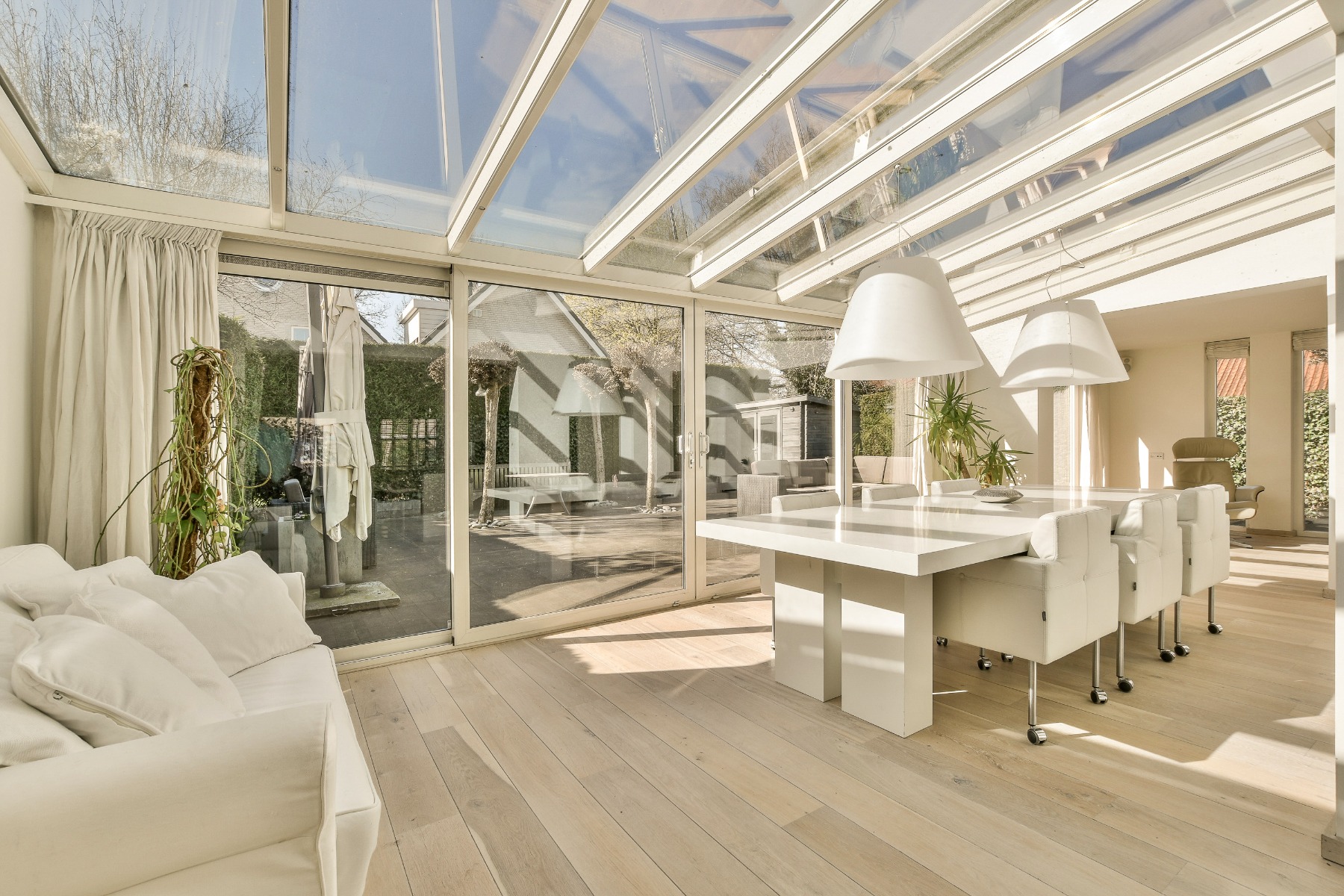
How much is underfloor heating conservatory installation?
An upfront cost for installing underfloor heating in your conservatory can vary depending on the type of system that you wish to install, as well as the size of the area that you wish to occupy. For instance, a loose wire electric heating system, to heat a m2 space, including heating controls, would cost approximately £50 – 75 plus VAT for electric, and £120 – 135 for wet underfloor heating. To get an accurate price, you can check for prices using Checkatrade.
Frequently Asked Questions
Is underfloor heating a good idea in a conservatory?
No matter if it's electric or wet underfloor heating, both provide excellent benefits for heating a conservatory. Unlike traditional central heating, underfloor heating helps maintain humidity in the air with comfortable heat, which is then evenly distributed throughout the room.
How much does it cost to put underfloor heating in a conservatory?
What is the cost of conservatory underfloor heating? For installing underfloor heating in a new conservatory, you can expect to pay approximately £50 to £75 per square meter for electric systems and £120 to £135 per square meter for wet underfloor heating.
What is the cheapest way to heat my conservatory?
Electric radiators and underfloor heating systems heat up and cool down quickly, converting all their electrical energy into heat. This makes them a more efficient and cost-effective option for conservatory heating compared to many alternatives.
What heating is best for a conservatory?
If you only plan to use your conservatory occasionally during the warmer months, an electric panel heater is a strong option. However, if you intend to use the space year-round, electric underfloor heating systems for conservatories are the better choice.
New to Underfloor Heating?
Use below links to browse our key pages


